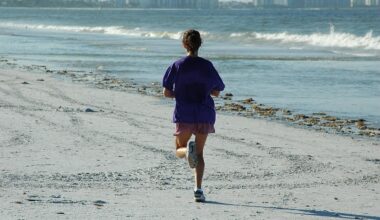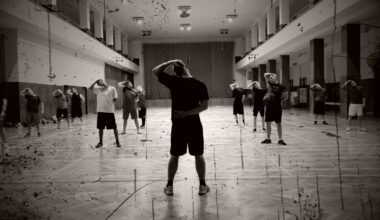Strategies to Enhance Motivation for Exercise in Older Adults
Enhancing motivation for exercise among older adults is crucial for maintaining their health and well-being. Numerous strategies can be implemented to inspire them to engage in physical activity. First, setting achievable goals is essential. When older adults set realistic targets, they are more likely to experience a sense of accomplishment, which can boost their motivation. Additionally, involving family and friends can play a significant role. Social support fosters a sense of belonging and encouragement, making exercise more enjoyable. Furthermore, creating a structured routine helps in integrating physical activity into their daily lives. Consistency is key, and having a specific time for exercise can reinforce the habit. Providing education about the benefits of regular exercise, such as improved mobility, enhanced mental health, and reduced risk of chronic diseases, can also spark interest. Tailoring fitness programs to individual preferences and physical abilities can ensure that older adults feel comfortable and valued. Finally, celebrating milestones, no matter how small, can further motivate them to continue their journey of fitness.
Incorporating technology into exercise routines can also significantly enhance motivation for older adults. Many older individuals are becoming more tech-savvy, which opens the door to various fitness apps and wearable devices. These tools can track progress, monitor heart rates, and provide reminders to stay active. They generate data that can serve as motivational feedback, showcasing improvements over time. Offering online video classes tailored to older adults can also be effective. It allows for flexibility and the comfort of exercising in a familiar environment. Encouraging participation in community fitness events or group classes can foster social connections, providing both motivation and enjoyment. These settings often create friendly competition and camaraderie. Moreover, integrating fun activities such as dance classes or walking clubs can make exercise feel less like a chore and more like a pleasure. Many older adults respond positively to engaging in activities they find enjoyable. Lastly, emphasizing the emotional and psychological rewards of regular exercise, including improved mood and enhanced sleep quality, can be powerful motivators. These aspects should be highlighted in promotional materials and during fitness discussions.
Creating a Positive Environment
A positive environment is essential for encouraging older adults to exercise regularly. This includes the physical space where they work out and the overall atmosphere of the activity. A welcoming, safe environment that is easy to navigate fosters their confidence and willingness to participate. Modifying equipment to meet their needs, such as providing supportive chairs or mats, can significantly contribute to their comfort. Group activities or classes should promote inclusivity and acceptance, ensuring that every individual feels valued regardless of their fitness level. Instructors should be trained to approach older adults with empathy and understanding, addressing their specific concerns. Comments and praises, combined with constructive feedback, can encourage continued participation. Additionally, ensuring access to amenities like water stations and rest areas can make the experience more enjoyable. It’s also important to consider environmental factors such as lighting and temperature, as these can affect older adults’ willingness to exercise. Engaging them in the design of their exercise routines, allowing them to choose activities they enjoy, can empower them. By fostering such a positive environment, motivation can be significantly enhanced.
Engagement in the decision-making process regarding physical activities fosters a sense of ownership over their fitness journey. When older adults can select which workouts or classes they participate in, they are more likely to commit and find joy in the experience. Providing flexible options such as strength training, aerobics, or yoga can cater to diverse interests and abilities. Another strategy includes integrating intergenerational programs where older adults can work out alongside younger individuals. These interactions can lead to new friendships, shared motivation, and mutual encouragement. This relationship fosters a supportive network that can increase accountability among participants. Encouraging them to share their personal stories and achievements within their groups can inspire others, thus creating a motivational ripple effect. Another area of focus is incorporating themed events or challenges that make exercising fun and exciting. For instance, organizing community walks or fitness challenges with prizes can motivate older adults to actively participate. This approach not only promotes physical activity but also enhances community spirit. Celebrating successes collectively reinforces a positive feedback loop where everyone feels proud of their accomplishments.
The Role of Nutrition
Nutrition plays a pivotal role in supporting exercise motivation for older adults. A well-balanced diet enhances energy levels and improves overall health, making physical activity more appealing. Educating older adults about the synergistic relationship between exercise and proper nutrition is essential. This includes understanding the importance of consuming nutrient-rich foods that fuel their bodies before and after workouts. Encouraging hydration is equally important; proper fluid intake can enhance performance and prevent fatigue during exercise. Workshops that focus on meal planning and nutrition can empower older adults to make healthier choices, complementing their fitness routines. Engaging them in discussions about how certain foods impact their energy and recovery can alter their perceptions of eating well. Moreover, preparing meals together in community settings can foster social interaction while promoting healthy eating habits. Providing resources like recipe cards or small cooking classes can lead to significant positive changes. Furthermore, offering simple, yet nutritious snacks during exercise sessions can reinforce the concept of nourishment. By instilling solid nutritional habits along with exercise, older adults can experience enhanced motivation and better overall fitness results.
Regular monitoring of progress can significantly boost motivation for exercise among older adults. Access to progress tracking tools, whether through fitness apps or simple journals, allows individuals to visually recognize their improvements. Setting specific, measurable goals enables them to see not only where they started but how far they have come. This progress can be highlighted during community gatherings or group classes to reinforce a sense of achievement. Furthermore, regular assessments, such as fitness evaluations, can provide valuable feedback. Conducting these assessments with supportive trainers or peers helps create a positive environment focused on growth rather than competition. Acknowledgment of milestones, such as increased stamina or strength, can stimulate further engagement. Engaging family members in the process can add another layer of support. When loved ones celebrate achievements, it amplifies the sense of motivation. Additionally, conducting surveys to understand the motivational factors that work for each individual can tailor strategies effectively. Addressing any barriers they may face in achieving their goals also plays a role. By regularly focusing on progress and celebrating achievements, older adults are encouraged to maintain their exercise routines.
Conclusion
In conclusion, enhancing motivation for exercise in older adults involves a multifaceted approach that includes setting goals, social support, education, and creating positive environments. Tailoring fitness programs to individual preferences while incorporating technology and nutrition can further engage this demographic. Fostering community ties through group activities and intergenerational engagement sparks motivation and accountability. Regular monitoring of progress reinforces their commitment and allows older adults to witness their achievements firsthand. Engaging family members in the fitness journey can amplify the support system, promoting a culture of health and wellness. With the right strategies in place, older adults can significantly enhance their motivation to exercise, leading to improved health outcomes and overall quality of life. Ongoing research and adaptation of programs will ensure that exercise remains accessible and enjoyable for older individuals. As society recognizes the importance of active aging, creating opportunities for older adults to engage in physical activity will become increasingly vital. By prioritizing motivation, we can empower older adults to lead healthier, more active lives.


